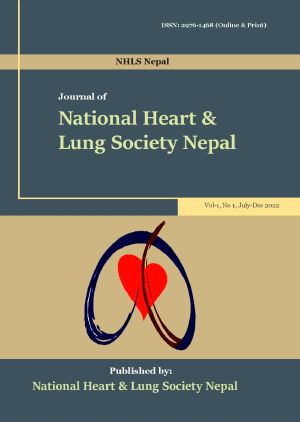Outcome of Percutaneous Transvenous Mitral Commisurotomy According to Age, Gender and Heart Rhythm
DOI:
https://doi.org/10.3126/jnhls.v1i1.52867Keywords:
age, atrial fibrillation, gender, mitral stenosis, PTMCAbstract
Background: Percutaneous transvenous mitral commisurotomy (PTMC) is the recommended treatment in the severe mitral stenosis with mitral valve area ≤ 1.5 sq. cm and favourable mitral valve morphology without Left atrium (LA) clot.
Methods: A retrospective study done for one year among all the patients who had undergone PTMC in 2016. Successful PTMC was defined as increase in Mitral valve area (MVA) more than or equal to 1.5 sq. cm or increase in area by more than 50% from baseline. Data was analyze using SPSS-20.
Results: Three hundred thirty sex patients with mean age 34.08 ±12.0 of which male were 97 ( 26.9 %.) and female were 239 (71.1 %). There were 225 (67%) sinus rhythm (SR) and 111 (33%) atrial fibrillation (AF). The median Pre PTMC area and Left atrial (LA) Pressure were 0.9 sq cm and 24 mmHg respectively. The overall success of PTMC was in 289 (86%). The successful outcome in age categories less than 20 years, 20-40, 40-60 and more than 60 years in order are 39 (83%), 174 (86.6%), 71 (86.6%) and 5 (83.3 %). Success for male was 84 (86.6%) and in female 205(86%). Success percentage in SR was 192 (86%) and in atrial fibrillation was 97 (87.4%).
Conclusion: The outcome of PTMC in terms of change in mitral valve area was similar to the different age categories, gender and presence and absence of atrial fibrillation.




